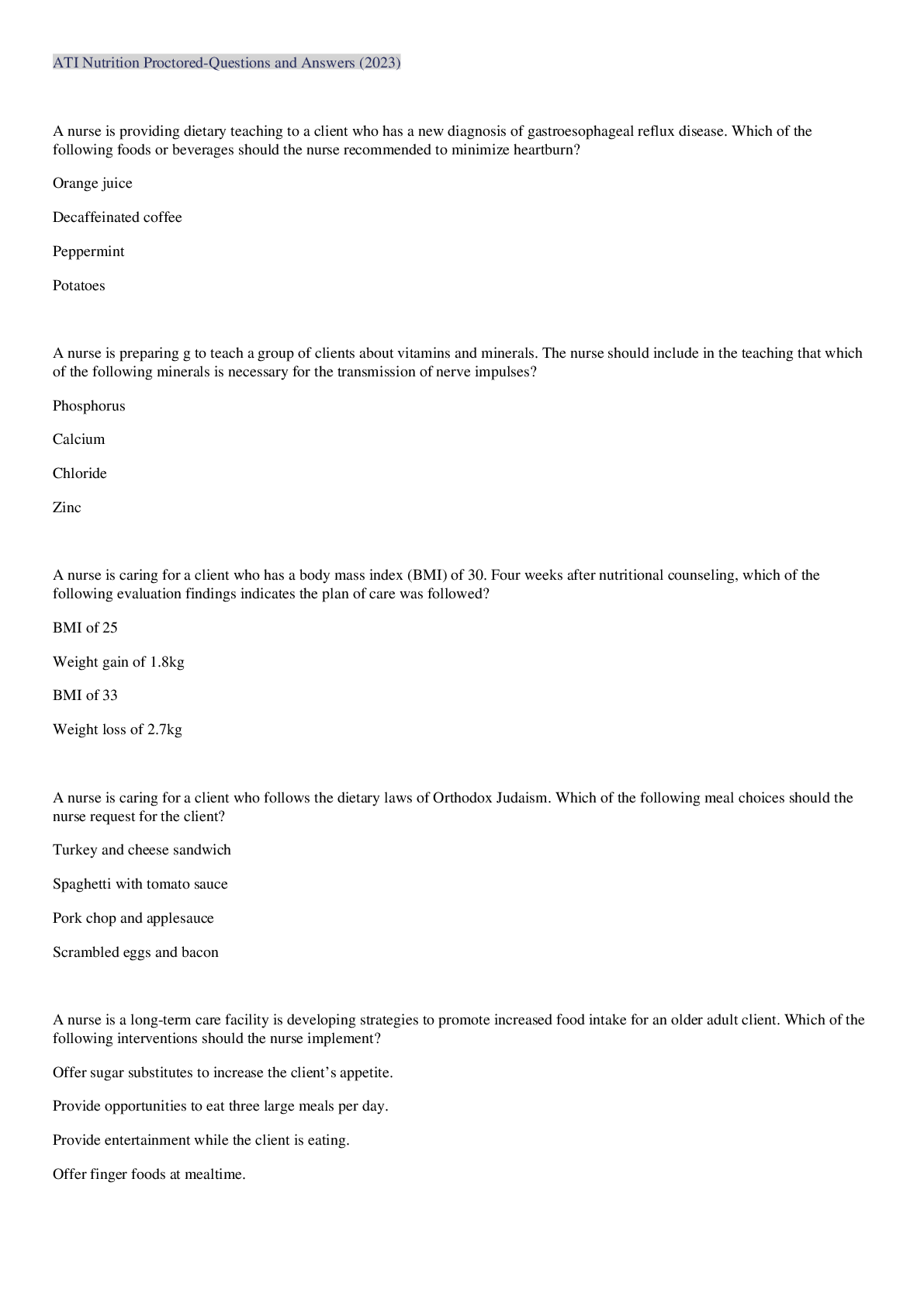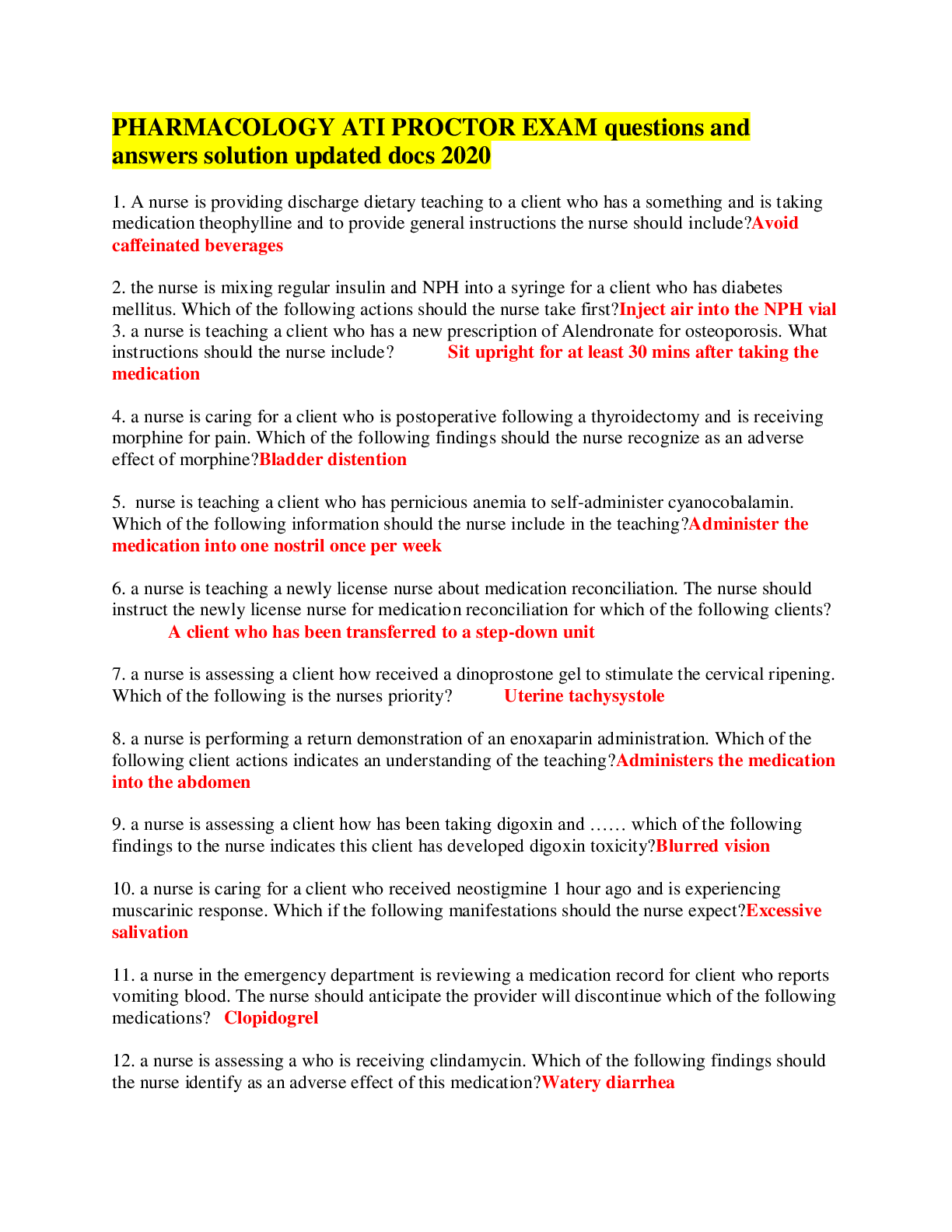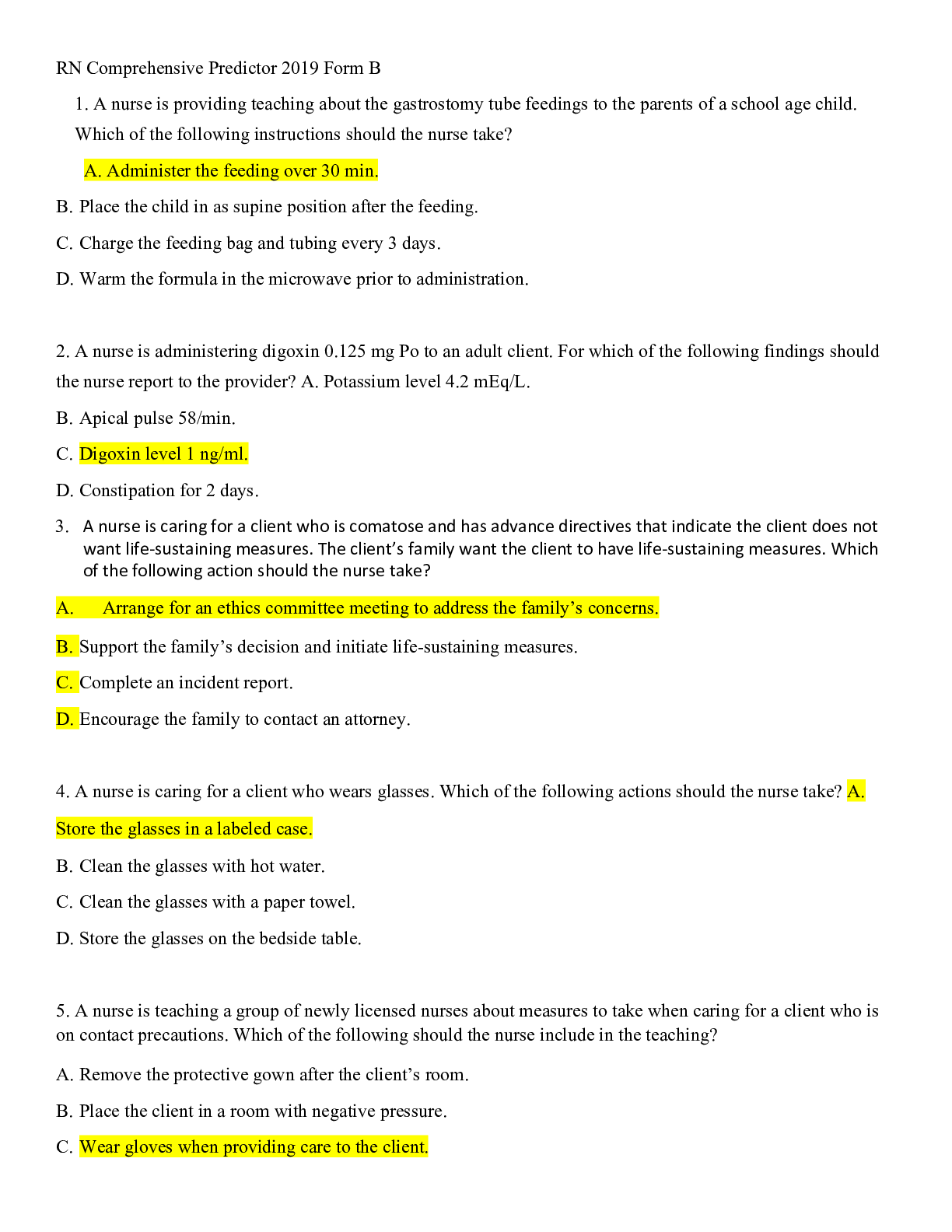ATI LEADERSHIP Proctored 70 QUESTIONS AND ANSWERS
Document Content and Description Below
LEADERSHIP 1. A client is brought to the emergency department following a motor-vehicle crash. Drug use is suspected in the crash, and a voided urine specimen is ordered. The client repeatedly refuse ... s to provide the specimen. Which of the following is the appropriate action by the nurse? a. Tell the client that a catheter will be inserted. b. Document the client’s refusal in the chart. c. Assess the client for urinary retention. d. Obtain a provider’s prescription for a blood alcohol level. 2. A nurse is making shift assignments in a hospital. Which of the following tasks is appropriate to assign to a licensed practical nurse? a. Pick up the meal trays after lunch. b. Administer a nasogastric tube feeding. c. Plan break times for assistive personnel. d. Determine adequacy of ventilator settings. 3. A nurse preceptor is evaluating a newly licensed nurse’s competency in assisting with a sterile procedure. Which of the following actions indicates the newly licensed nurse is maintaining sterile technique? (SATA) a. Places sterile items within a 1.25 cm (0.5 in) border around the edges of the sterile field b. Opens the sterile pack by first unfolding the top flap away from her body c. Prepares a container of sterile solution on the field after putting on sterile gloves d. Removes the outside packaging of a sterile instrument before dropping it onto the sterile field e. Holds the sterile solution bottle with the label facing up 4. A nurse enters a client’s room and identifies that the client is receiving too much IV fluid because the IV pump is not working properly. Which of the following actions should the nurse take first? a. Auscultate the client’s lungs. b. Notify the provider. c. Place a faulty equipment tag on the pump. d. Complete an incident report. 5. A nurse is planning care for a group of clients and can delegate care to a licensed practical nurse (LPN) and an assistive personnel. Which of the following tasks should the nurse assign to the LPN? a. Reinforcing teaching with a client who is learning to self-administer insulin b. Ambulating a client who is scheduled for discharge later in the day c. Administering morphine IV bolus to a client who is __ hr postoperative d. Admitting a new client who has chronic back pain to the unit 6. A nurse is supervising a newly licensed nurse who is performing surgical asepsis. After donning a sterile gown and gloves, which of the following actions by the newly licensed nurse demonstrates correct aseptic technique? a. The nurse applies goggles. b. The nurse turns her back to the sterile field. c. The nurse holds her hands above her waist. d. The nurse puts on a face mask. 7. A nurse who is caring for a group of clients delegates collection of vital signs to an assistive personnel (AP). Which of the following actions should the nurse take to evaluate the delegated task? a. Review vital sign trends at the end of the shift. b. Recheck vital signs that are outside the expected reference range. c. Ask the AP to write a summary of the delegated tasks during the shift. d. Compare the vital signs the AP obtained with those taken by another AP on a previous shift. 8. A nurse is caring for four clients. Which of the following tasks can be delegated to an assistive personnel? a. Obtaining a stool sample from a client who has renal failure b. Monitoring a client who has a fluid restriction c. Assessing a client who just returned from hemodialysis d. Reviewing dietary instructions for a client who has kidney stones 9. A nurse is triaging a group of clients following a disaster. Which of the following clients should the nurse recommend for treatment first? a. A client who has a neck injury and is unable to breathe spontaneously b. A client who has two open chest wounds with a left tracheal deviation c. A client who has major burns over 75% of her body surface area d. A client who has bipolar disorder and is exhibiting signs of hallucination (Class 3) 10. A nurse manager is reviewing guidelines for informed consent with the nursing staff. Which of the following statements by a staff nurse indicates that the teaching was effective? a. “A family member can interpret to obtain informed consent from a client who is deaf.” b. “Consent can be given by a durable power of attorney.” c. “Guardian consent is required for an emancipated minor.” d. “The nurse can answer any questions the client has about the procedure.” 11. A nurse is caring for four clients. For which of the following clients should the nurse collaborate with the facility ethics committee? a. A middle adult client who leaves the facility against medical advice b. An older adult client who has advanced directives on file c. A young adult client who is participating in a medical research study d. An adolescent client whose parents refuse a blood transfusion for religious reasons 12. A nurse in an ambulatory care setting is orient a newly licensed nurse who is preparing to return a call to a client. The nurse should explain that which of the following is an objective of telehealth? a. Assessing client needs b. Developing client treatment protocols c. Providing medication reconciliation d. Establishing communication between providers (Community Health pg. 75) 13. A nurse is providing discharge teaching to a client who has a new diagnosis of diabetes. The client expresses concern about the cost of blood-glucose monitoring supplies. Which of the following actions should the nurse take? a. Refer the client to the social services department. b. Provide the client with a week’s worth of supplies from the hospital (still needs help paying after) c. Ask the provider about the possibility of less frequent monitoring (pt needs to monitor often) d. Recommend the client reuse the testing lancets (breaks the safety & infection protocol) 14. A charge nurse is receiving change-of-shift report. Which of the following situations should the charge nurse address first? a. A nurse on the previous shift wrote an incident report about a medication error. b. Two staff members have called to say they will be absent. c. Transport assistance is unavailable to take a client to occupational therapy. d. The emergency department nurse is waiting to give report on a new admission. 15. A nurse who is precepting a newly licensed nurse is discussing the client assignment for the shift. Which of the following actions should the nurse preceptor take first to demonstrate appropriate time management? a. Complete required tasks. b. Review the client’s new laboratory values. c. Determine client care goals (set/plan goals) d. Document assessment data. 16. A charge nurse is reviewing information about HIPAA with a group of staff nurses. Which of the following statements by a staff nurse indicates understanding? a. “Clients who participate in research studies forfeit their HIPAA right to privacy.” b. “HIPAA allows facility-specific coding of client health care information to ensure privacy.” c. “HIPAA prohibits the uploading of photographs of client’s providers to social media sites.” d. “HIPAA allows clients to request a review of their own medical records.” 17. A nurse is caring for a client who has a tumor. The provider recommends surgery. The client refuses, but the client’s partner wants the surgery performed. Which of the following is the deciding factor in determining if the surgery will be done? a. Whether the client understands the risk of refusing the procedure b. Whether the facility ethics committee reached a consensus on the case c. Whether the partner is the client’s durable power of attorney for health care d. Whether the client’s refusal is based on religious belief 18. A charge nurse is planning the care of four newborns. An assistive personnel and licensed practical nurse are available for staffing. Which of the following tasks should the nurse assign to a licensed practical nurse? a. Conduct the newborn hearing screening. (RN assessment) b. Administer a hepatitis B vaccine. c. Perform a New Ballard screening. (RN assessment) d. Obtain vital signs. (CNA) 19. During a staff meeting a unit manager reviews the results for documenting client education and finds that they are below the benchmark. Which of the following strategies should the nurse manager implement first? a. Train LPNs to reinforce teaching with clients using a standardized teaching plan. b. Determine factors that interfere with the documentation of client education. c. Include documentation of client education as part of unit nurses’ annual performance evaluation. d. Offer incentives for the staff once the unit’s results are back in adherence with the benchmark. 20. A nurse is explaining ethics and values to a newly licensed nurse. The nurse should explain that preventing client injury by removing a fall hazard demonstrates which of the following ethical principles? a. Utility b. Autonomy c. Nonmaleficence d. Veracity 21. A nurse is caring for a group of clients. Which of the following clients should the nurse plan to assess first? a. A client who has congestive heart failure and has lost 0.9 kg (2 lb) in the past 24 hr (improvement) b. A client who has diabetes mellitus and reports paresthesia in his fingers and toes (ABC--circulation) c. A client who has a nasogastric tube and has crackles in the lungs (ABC--airway) d. A client who has a new diagnosis of Graves’ disease and a TSH level of 0.2 microunits/mL 22. A charge nurse is planning to evacuate clients on the unit because there is a fire on another floor. Which of the following clients should the nurse evacuate first? a. A client who is in Buck’s traction for a left hip fracture (can’t necessarily move too much) b. A client who is 1 day postoperative following thoracic surgery and has a chest tube (possible physical instability) c. A client who is confused and restrained for safety (still needs continual nursing care/assessment) d. A client who is receiving IV chemotherapy and is ambulatory 23. A nurse enters the room of a client who is unconscious and finds that the client’s son is reading her electronic medical records from a monitor located at the bedside. Which of the following actions should the nurse take first? a. Recommend the son meet with the provider to get information about his mother’s condition. b. Report the possible violation of client confidentiality to the nurse manager. c. Complete an incident report regarding the breach of the client’s confidentiality. d. Log out the computer so that the client’s son is unable to view his mother’s information. 24. A nurse is preparing a client for cardiac catheterization. Just before the procedure, the client asks the nurse about the risks of the procedure. Which of the following actions should the nurse take? a. Explain the risks of the procedure to the client. b. Convey the client’s request to the nurse who witnessed the consent. c. Check to see if the medial record indicates the provider explained the procedure to the client. d. Notify the provider about the client’s concerns. 25. A nurse is prioritizing care after receiving change-of-shift report on four clients. Which of the following clients should the nurse assess first? a. A client who reports a headache with sensitivity to light b. A client who reports an urge to void but has not urinated during the prior shift c. A client who reports indigestion and pain in her jaw d. A client who reports feeling lightheaded when he stands up from a lying position 26. A charge nurse notices that two staff nurses are not taking meal breaks during their shifts. Which of the following actions should the nurse take first? a. Discuss time management strategies with the nurses. b. Determine the reasons the nurses are not taking scheduled breaks. Assess first c. Provide coverage for the nurses’ breaks. d. Review facility policies for taking scheduled breaks. 27. A nurse is preparing to delegate bathing and turning of a newly admitted client who has end-stage bone cancer to an experienced assistive personnel (AP). Which of the following assessments should the nurse make before delegating care? a. Has the AP checked the client’s pain level prior to turning her? (RN only - do not delegate what you can EAT = evaluate, assess, teach) b. Is the client’s family present so the AP can show them how to turn the client? (this is not necessary) c. Has data been collected about specific client needs related to turning? (Assessment of holistic care r/t pt needs and what the experienced AP can do) d. Does the AP have the time to change the client’s central IV line dressing after turning her? (AP cannot change dressings) 28. A nurse is preparing to transfer a client from the emergency department to a medical-surgical unit using the SBAR communication tool. Which of the following information should the nurse include in the background portion of the report? a. A prescribed consultation -under situation b. The client’s vital signs c. The client’s name -under situation d. The client’s code status -under situation 29. A nurse is planning discharge for a client who has rheumatoid arthritis. Which of the following statements by the client should the nurse identify as an indication that a referral to an occupation therapist is necessary? a. “I need some help planning my meals to maintain my weight.” b. “I am tired of having pain in my joints all the time.” c. “I’m having difficulty climbing the stairs at my house.” d. “I will need assistance with bathing.” 30. A nurse in the emergency department is caring for a 16-year-old client who reports abdominal pain and is accompanied by an adult neighbor. The provider diagnoses a ruptured appendix and states that the client requires an emergency appendectomy. Which of the following actions should the nurse? a. Ask the adult neighbor to sign the consent form. b. Obtain consent from the hospital administrator. c. Witness the client signing the consent form. d. Attempt to notify the client’s guardian to obtain consent. 31. A nurse on a medical-surgical unit is caring for four clients. Which of the following findings is the highest priority? a. A client who had a cardiac catheterization whose capillary refill in the great toe is 4 seconds b. A client who has COPD and has an oxygen saturation of 90% c. A client who had a cholecystectomy 6 hr ago and is requesting pain medication d. A client whose TPN was discontinued 4 hr ago and is requesting clear liquids 32. A charge nurse suspects that a staff nurse is chemically impaired. Which of the following actions should the charge nurse take? a. Assign clients who are not prescribed narcotics to the staff nurse. b. Collect data about the staff nurse to support further action. c. Report the staff nurse to the facility ethics committee. d. Counsel the staff nurse about substance use. 33. A nurse is assessing a client’s comprehension of a pulmonary function test prior to the procedure. Which of the following client statements indicates to the nurse an understanding of the procedure? a. “I will be given contrast dye during this test.” b. “I might have to wear a nose clip during this test.” c. “I might have a tube inserted into my airway during the test.’ d. “I will run on a treadmill during this test.” 34. A nurse in the emergency department is triaging four clients. Which of the following clients should the nurse recommend to be examined first? a. A toddler who has a 2 cm (0.79 in) head laceration oozing dark red blood b. An adolescent client who has an injured ankle and reports a pain level of 8 on a scale from 0 to 10 c. An older adult client who has dyspnea and a respiratory rate of 26/min d. An adult client who has large ecchymosis on both legs 35. A home health nurse finds piles of newspapers in the hallway of a client’s home. The nurse explains the need to discard the newspapers for safety reasons. The client agrees to move the newspapers into the living room. Which of the following conflict resolution strategies has the nurse used? a. Collaborating b. Smoothing c. Accommodating d. Compromising 36. A nurse is planning to delegate client care assignments. Which of the following tasks should the nurse plan to delegate to an assistive personnel? a. Advising a client on self-administration of acetaminophen b. Informing a family of a client’s progress in physical therapy c. Teaching a client to perform a finger-stick for testing blood glucose levels d. Performing post mortem care prior to transferring the client to the morgue 37. A nurse is providing discharge teaching to a client following a total knee arthroplasty. Which of the following information should the nurse include (SATA) a. Advance directives information b. Contact information for the physical therapist c. Medication guidelines information d. Insurance information e. Information about follow-up care 38. A nurse is planning to discharge a client who has terminal cancer and suggests that the family might benefit from respite services. When the client’s partner asks how this service can help, which of the following responses by the nurse is appropriate? a. “This service offers psychological interventions during and after your wife’s illness.” b. “The clinicians help reduce the severity of your wife’s physical problems.” c. “This service delivers meals and supplies to reduce your errands away from home.” d. “It makes it possible for you to have some time away from caring for your wife.” 39. A nurse is teaching a client how to use a finger-stick glucometer at home. Which of the following instructions should the nurse include? a. Warm the hands prior to piercing the skin. b. Cap the lancet prior to putting it in the trash.- never recap c. Elevate the arm for 1 min before taking the blood sample.- has to be down so gravity can assist to milk the blood out . d. Obtain the blood sample from the finger pads. 40. A nurse is assessing a client who had a recent stroke. Which of the following findings should indicate the need for referral to an occupational therapist? a. Receptive aphasia→ unable to understand language in its written or spoken form b. Facial drooping→ speech therapist c. Memory loss d. Unilateral neglect –is one of the disabling features of stroke, and is defined as a failure to attend to the side opposite a brain lesion. 41. A nurse is participating in the development of a disaster management plan for a hospital. The nurse should recognize that which of the following resources is the highest priority to have available in response to a bioterrorism event? a. A network for communication between staff members and families b. A mental health specialist on the response team c. A sufficient supply of personal protective equipment d. A system for tracking client information 42. A nurse in a clinic is reviewing laboratory reports for a group of clients. Which of the following diseases should the nurse report to the state health department? a. Rotavirus b. Pertussis c. Respiratory syncytial virus d. Group B streptococcal disease 43. A charge nurse is teaching a newly licensed nurse about proper cleaning of [Show More]
Last updated: 1 year ago
Preview 1 out of 25 pages
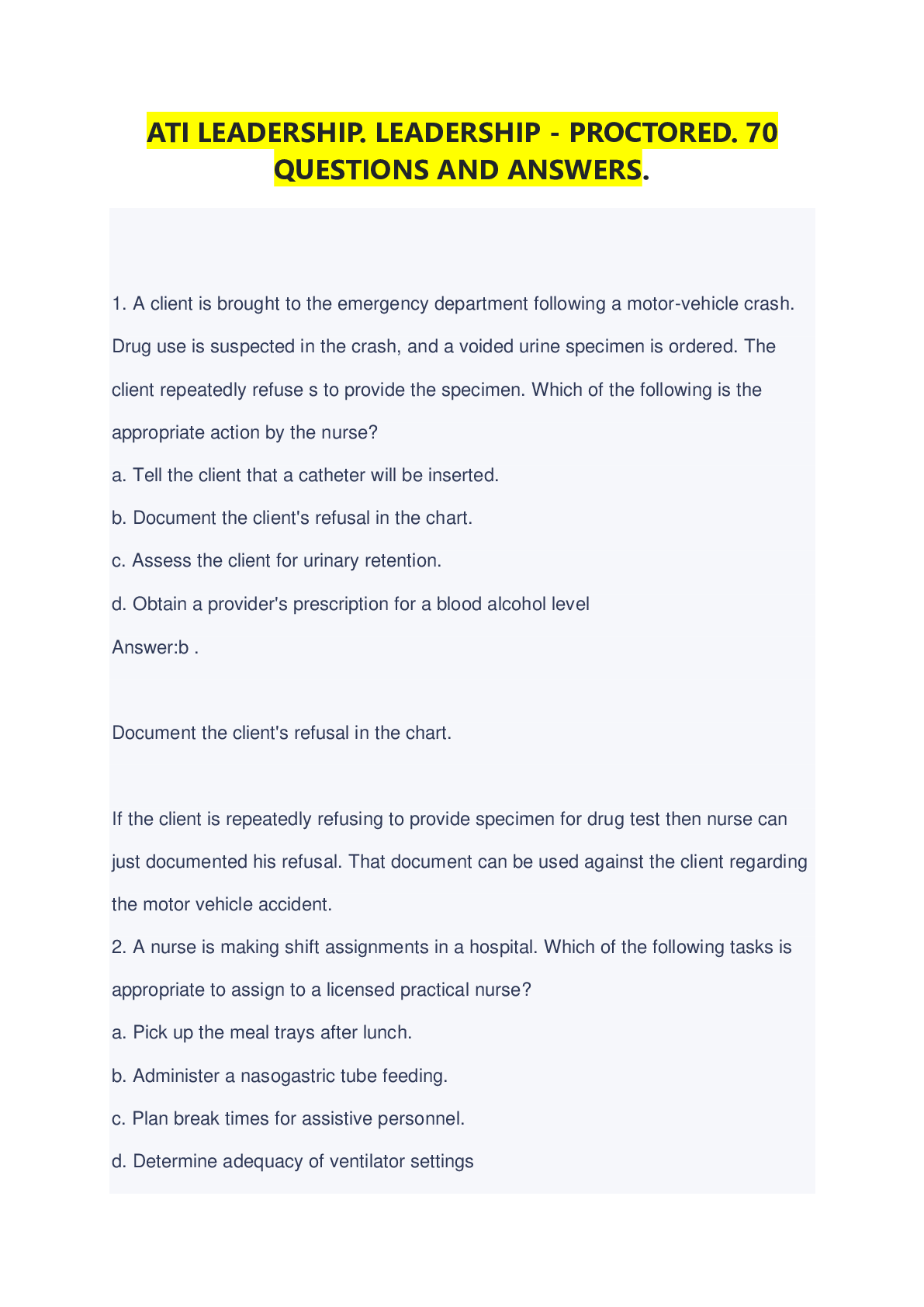
Reviews( 0 )
Document information
Connected school, study & course
About the document
Uploaded On
Apr 16, 2023
Number of pages
25
Written in
Additional information
This document has been written for:
Uploaded
Apr 16, 2023
Downloads
0
Views
31

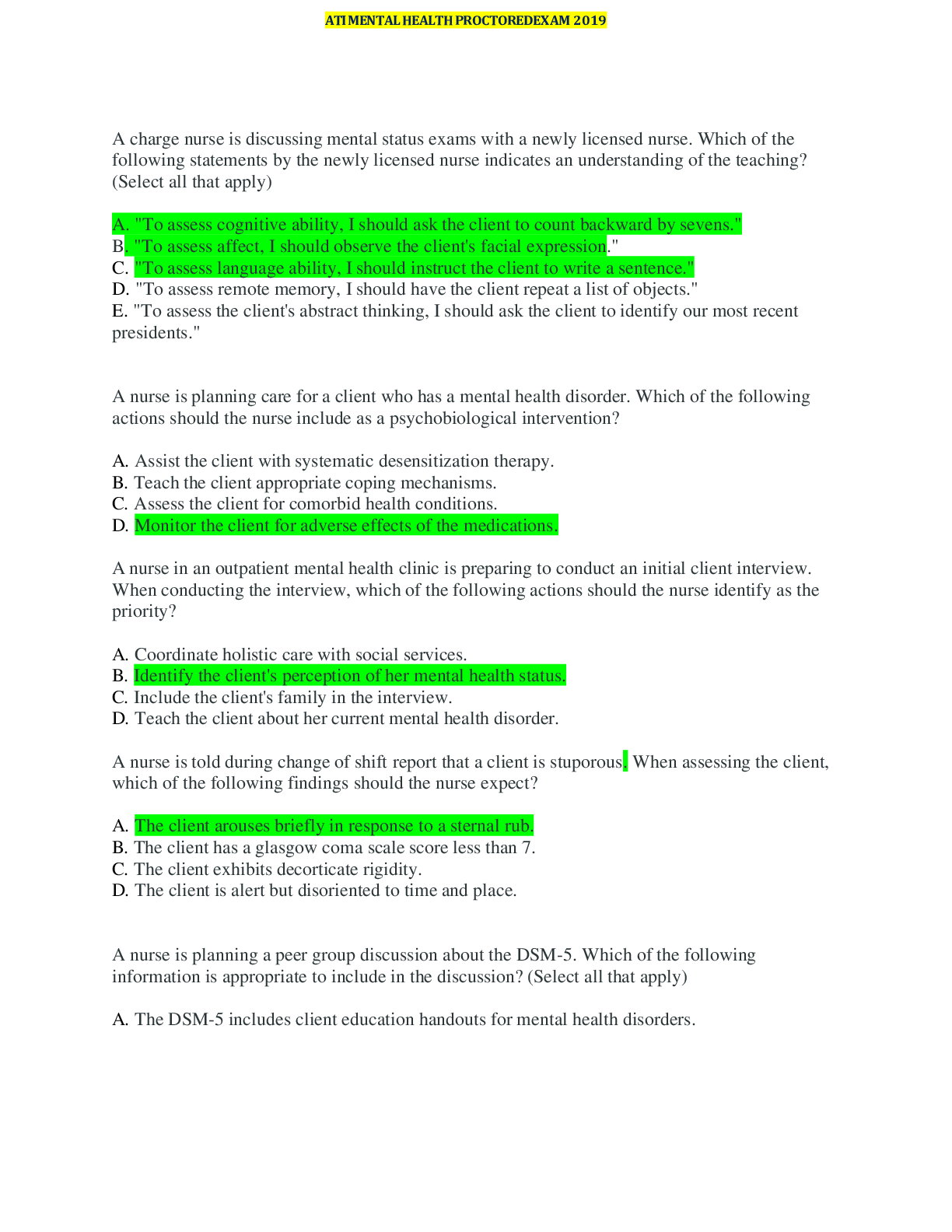
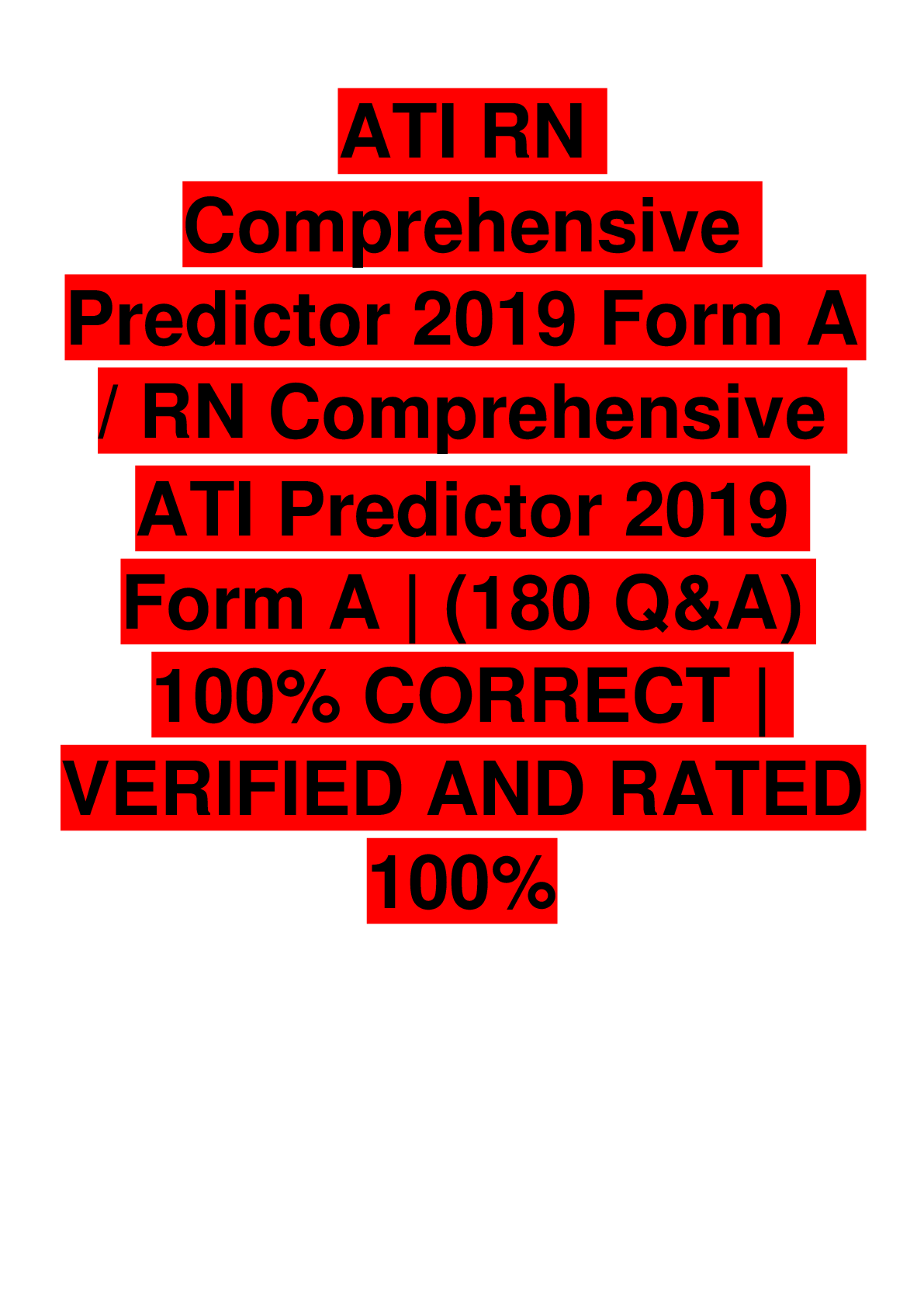
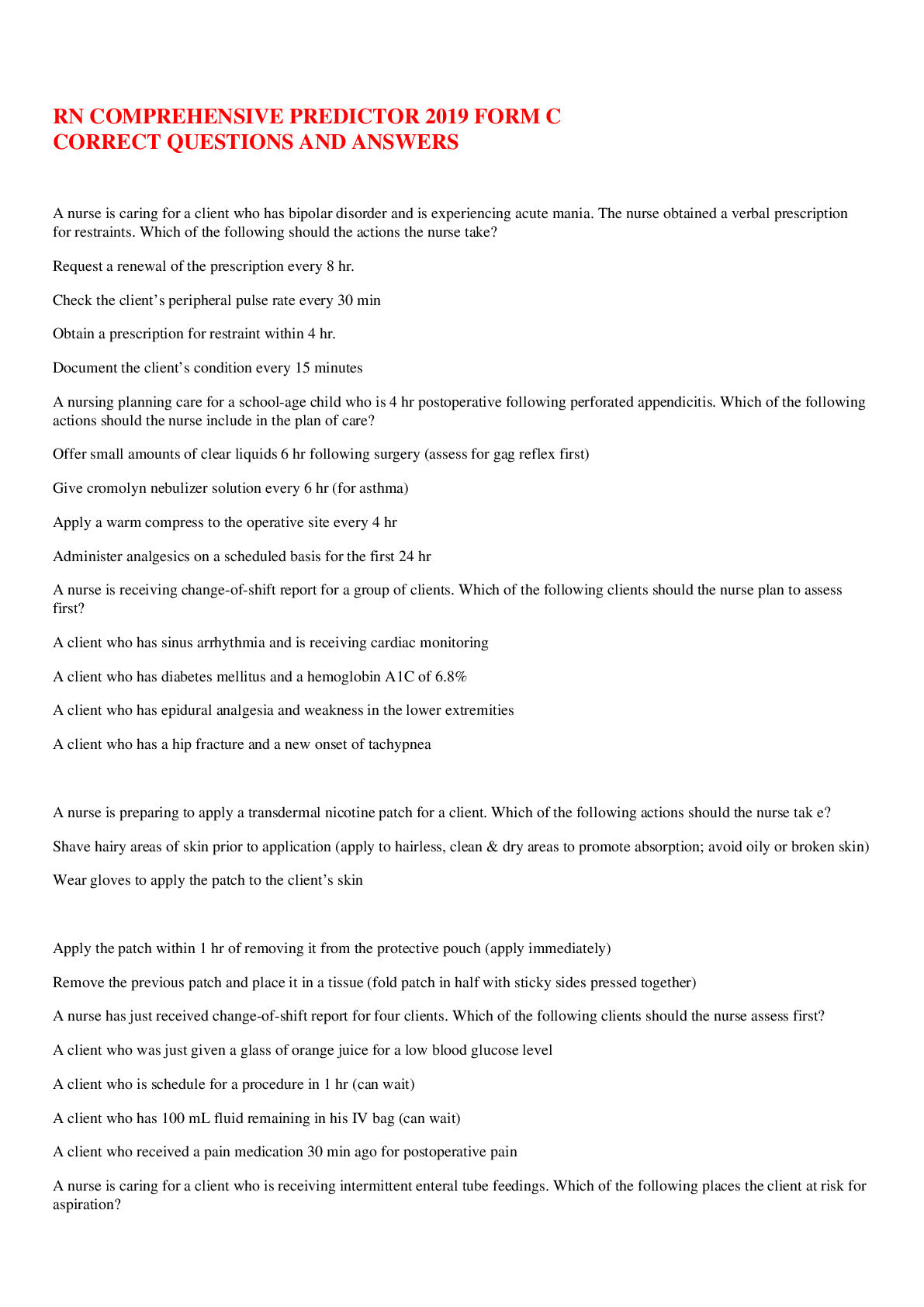


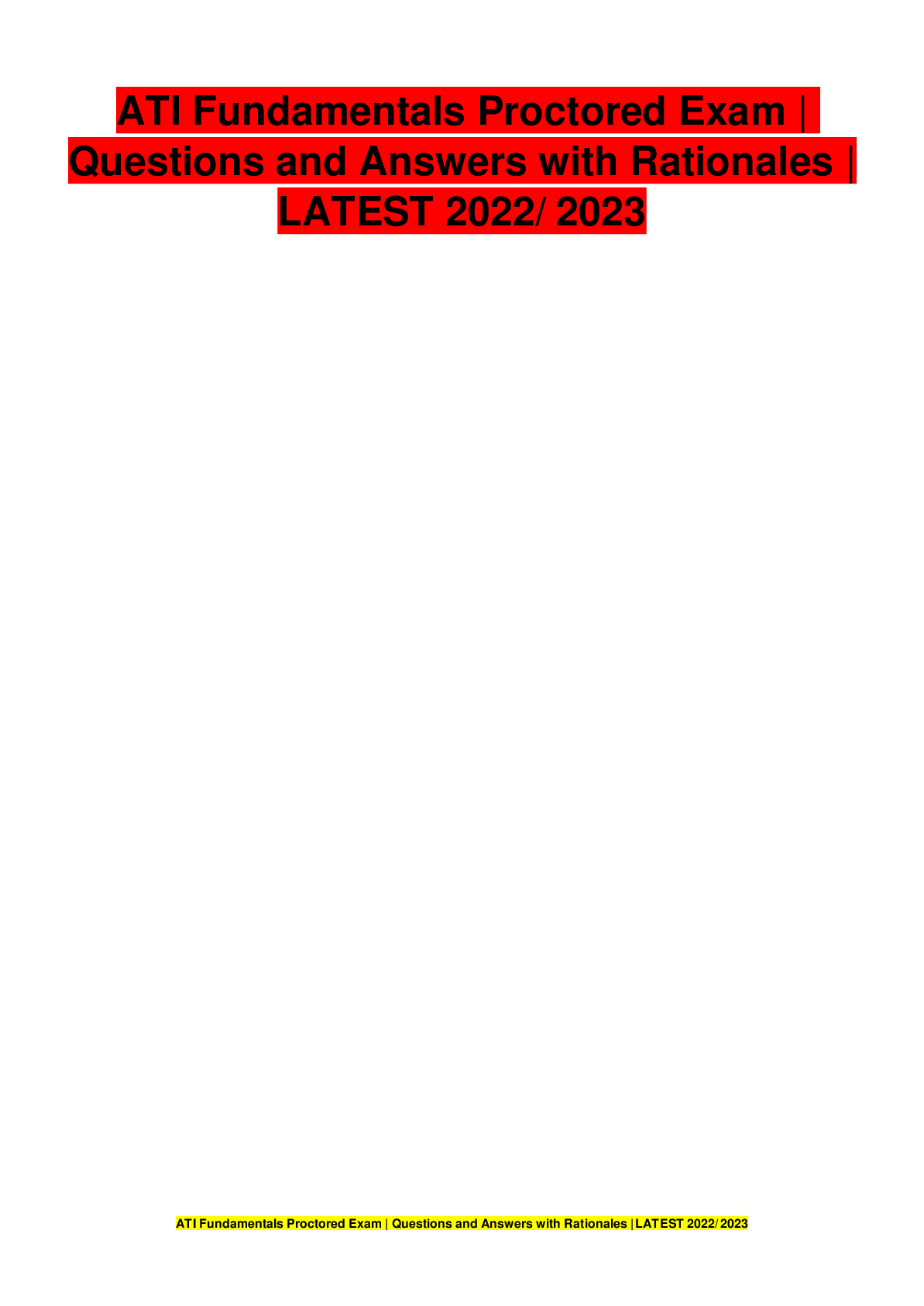
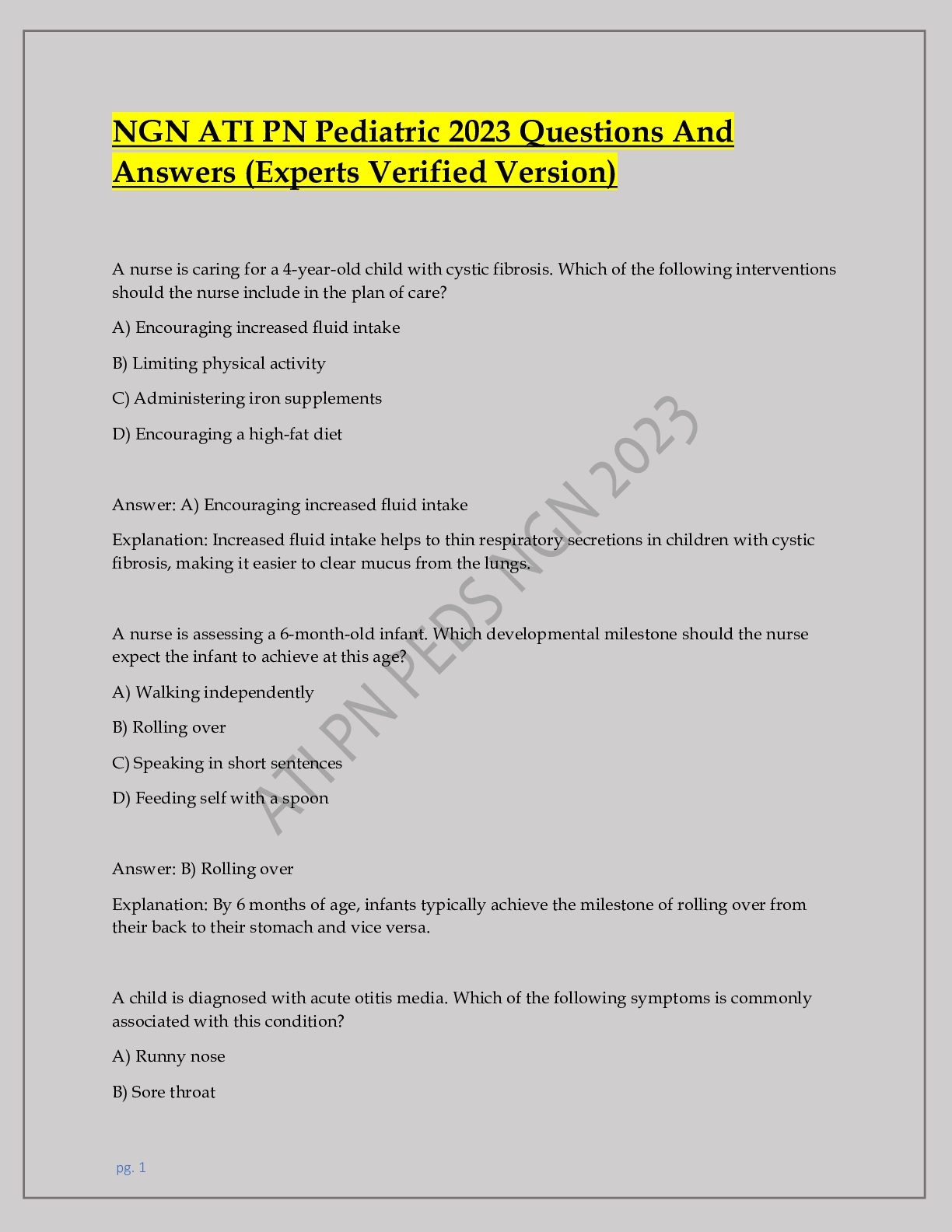

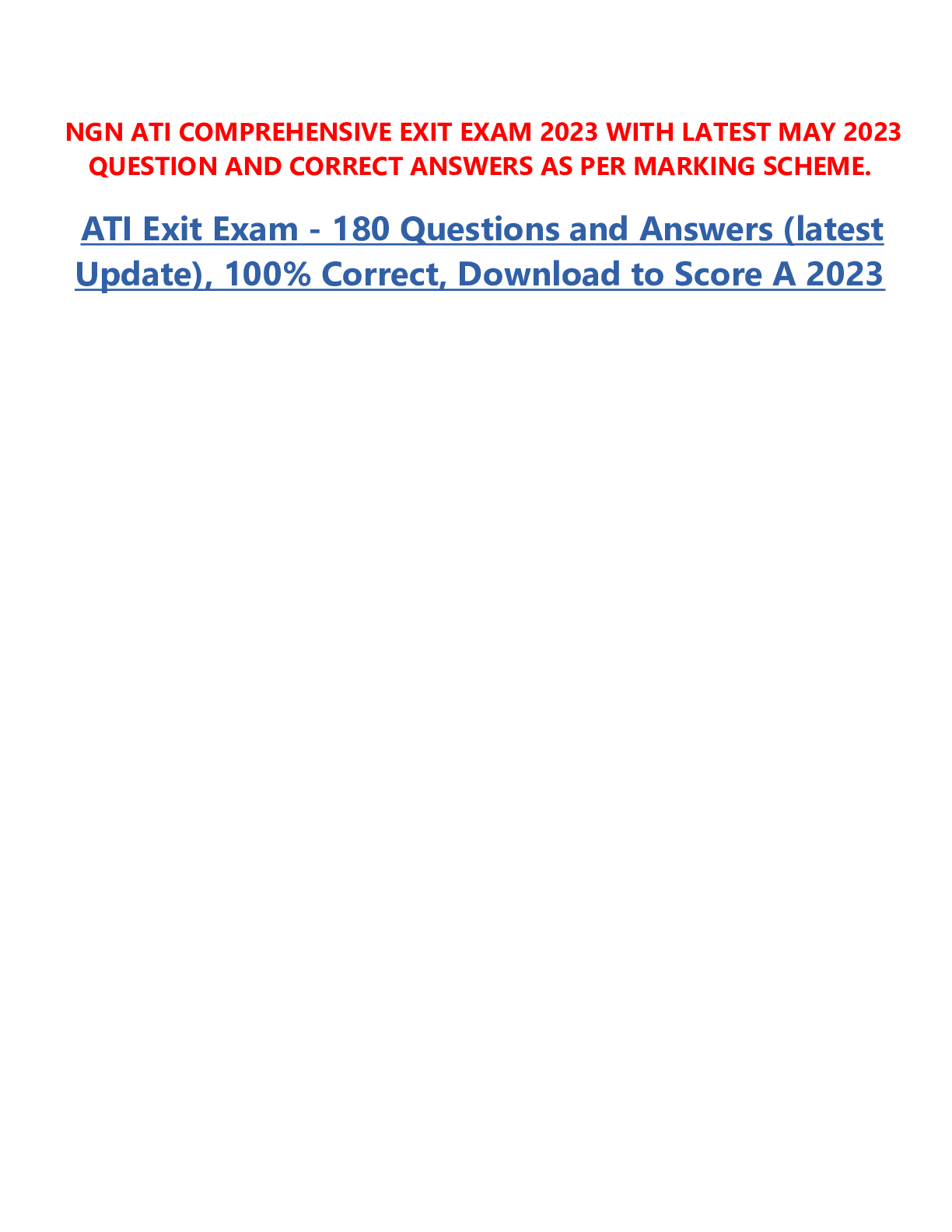
_Already Graded A.png)
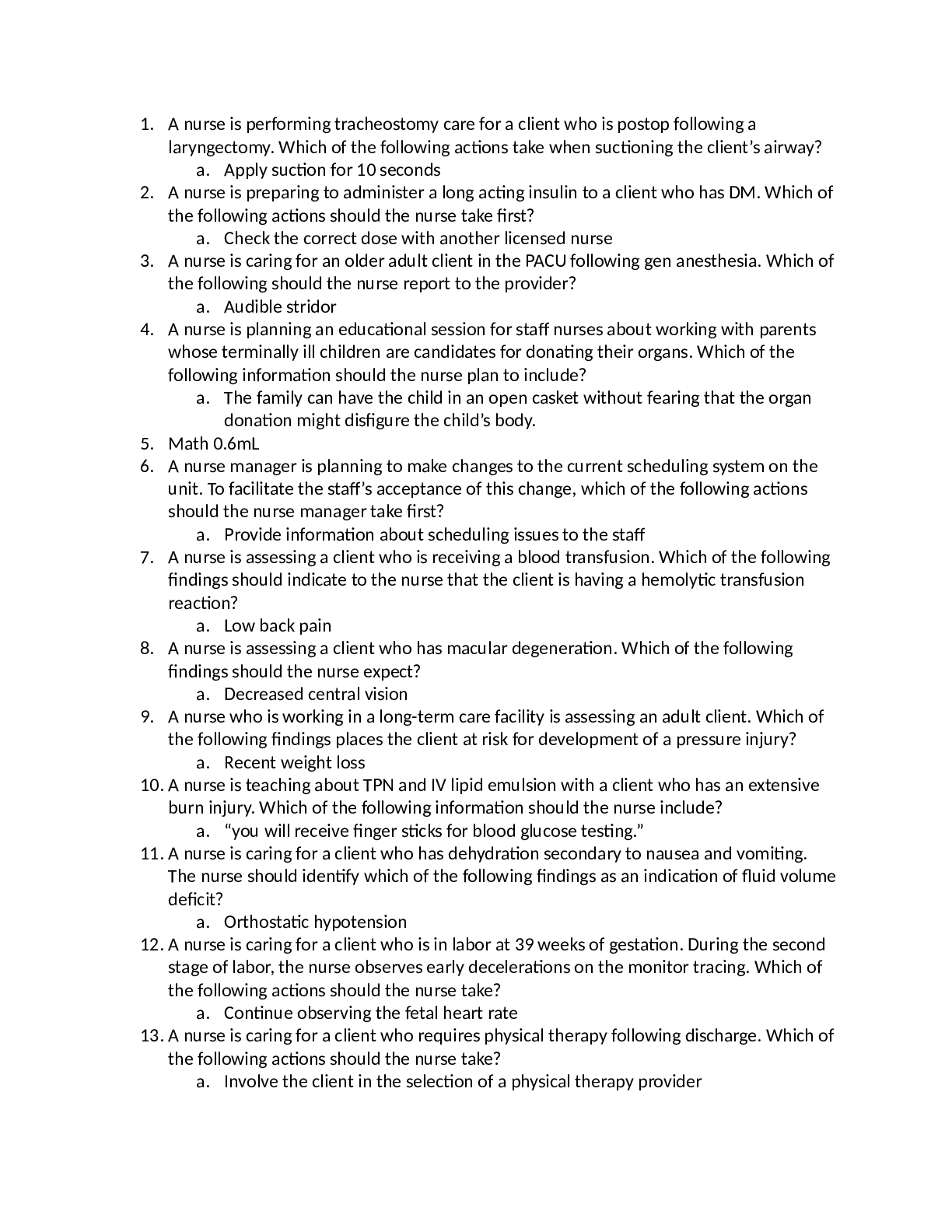
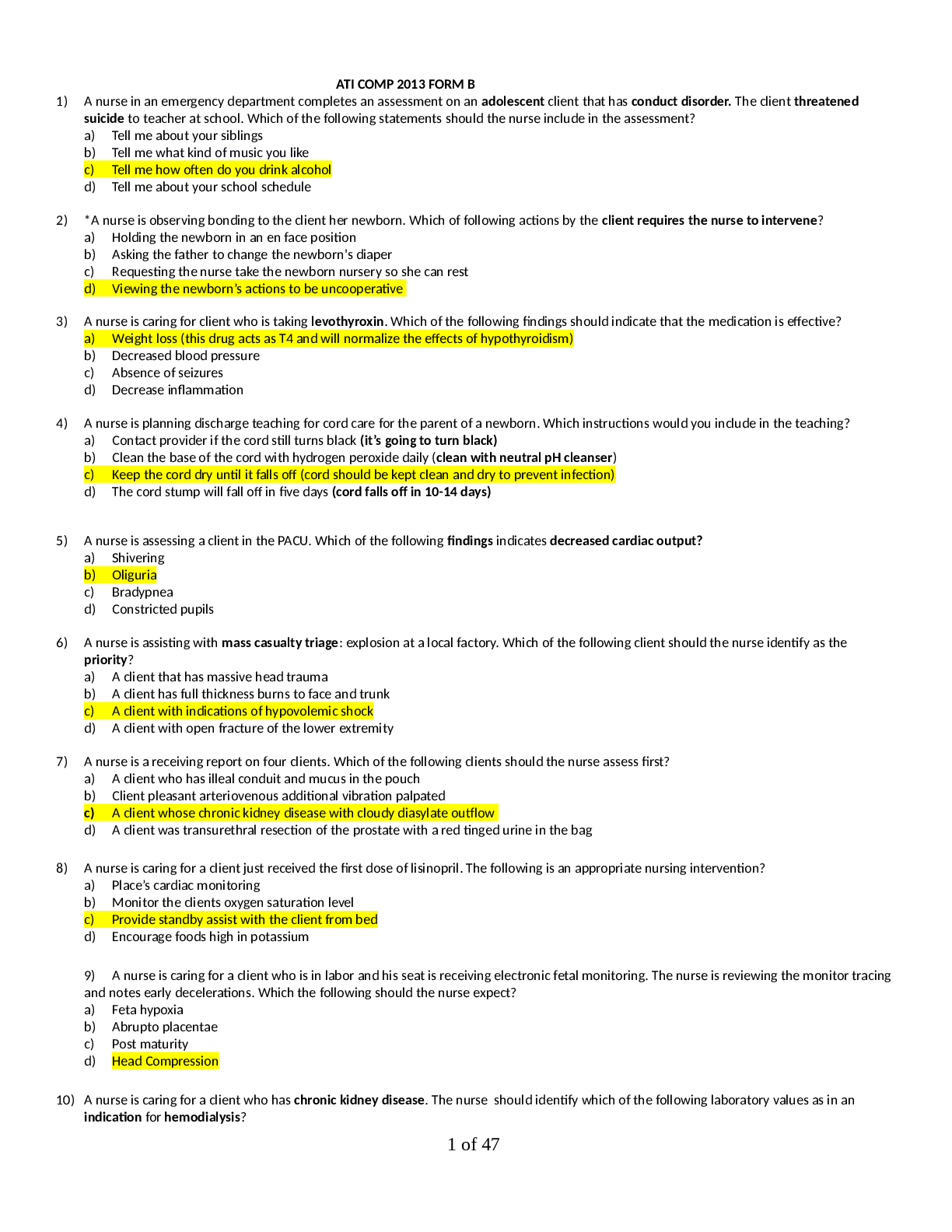
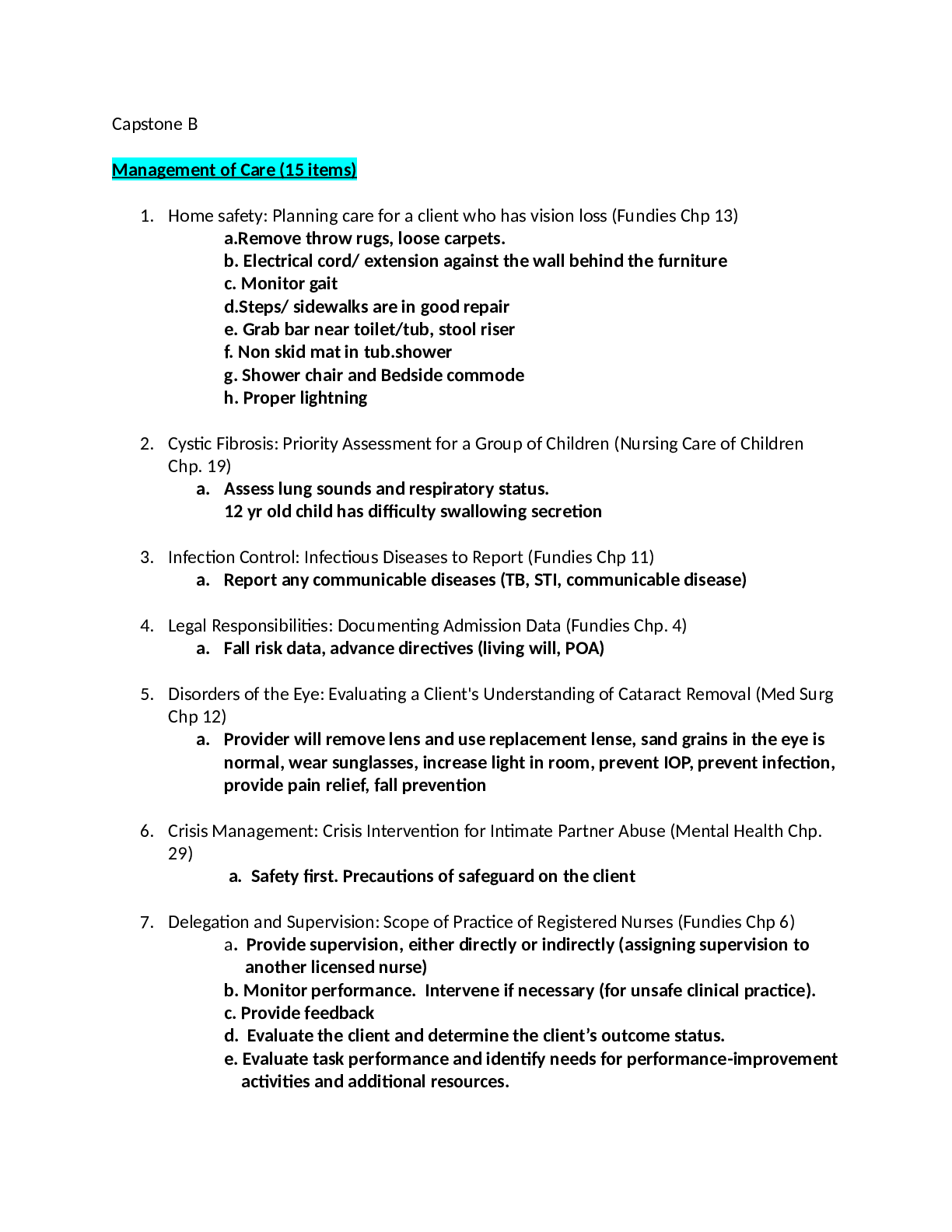
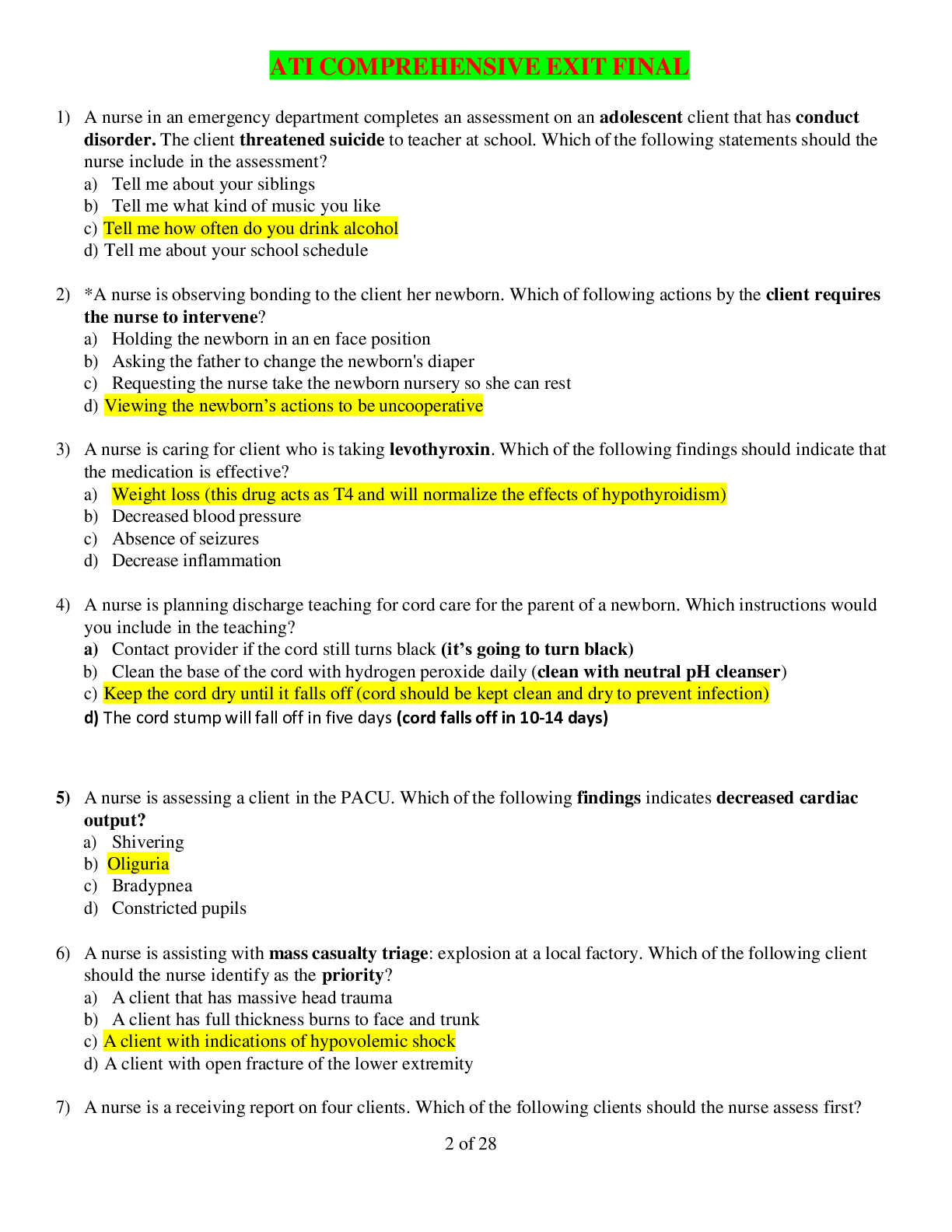
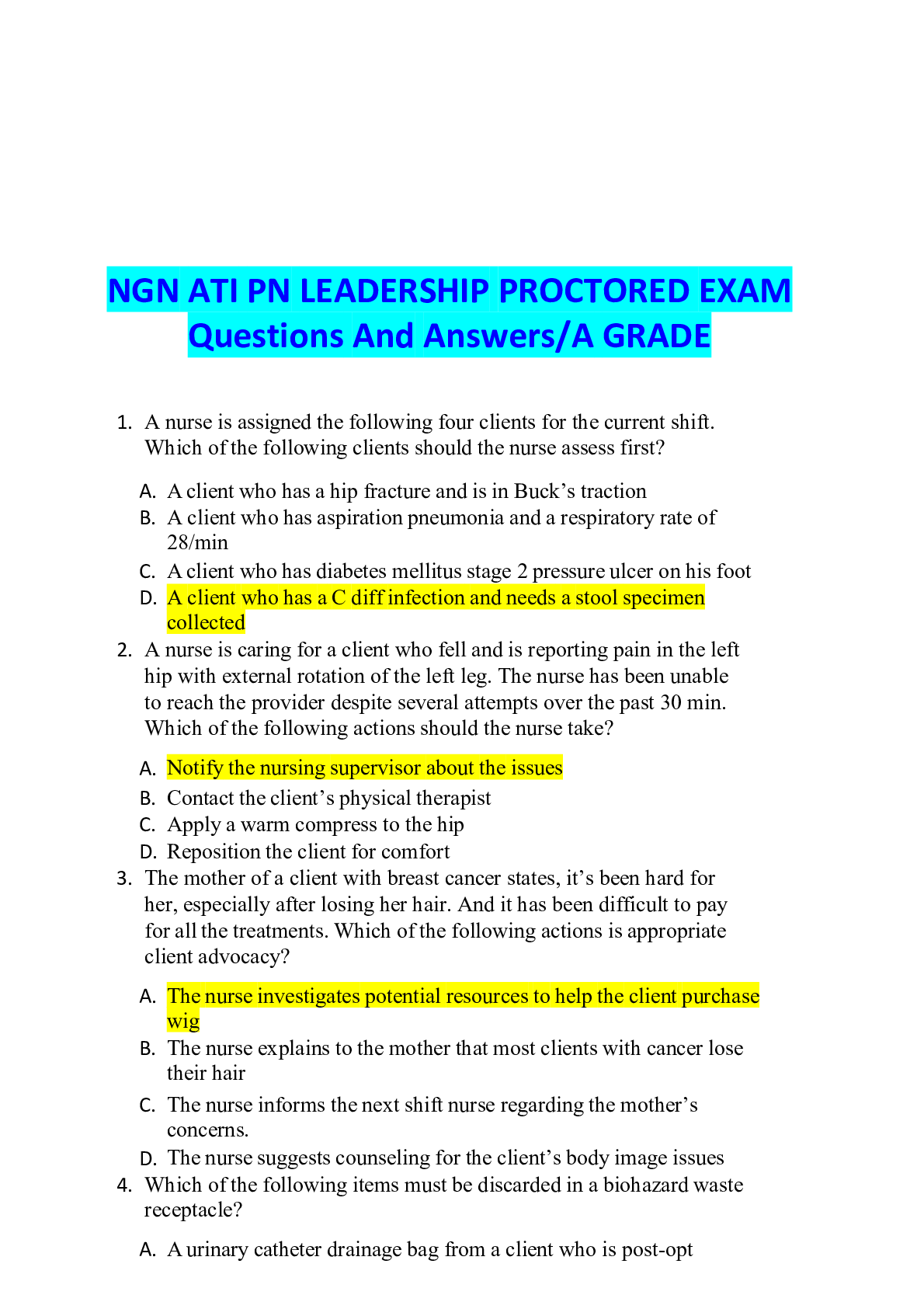
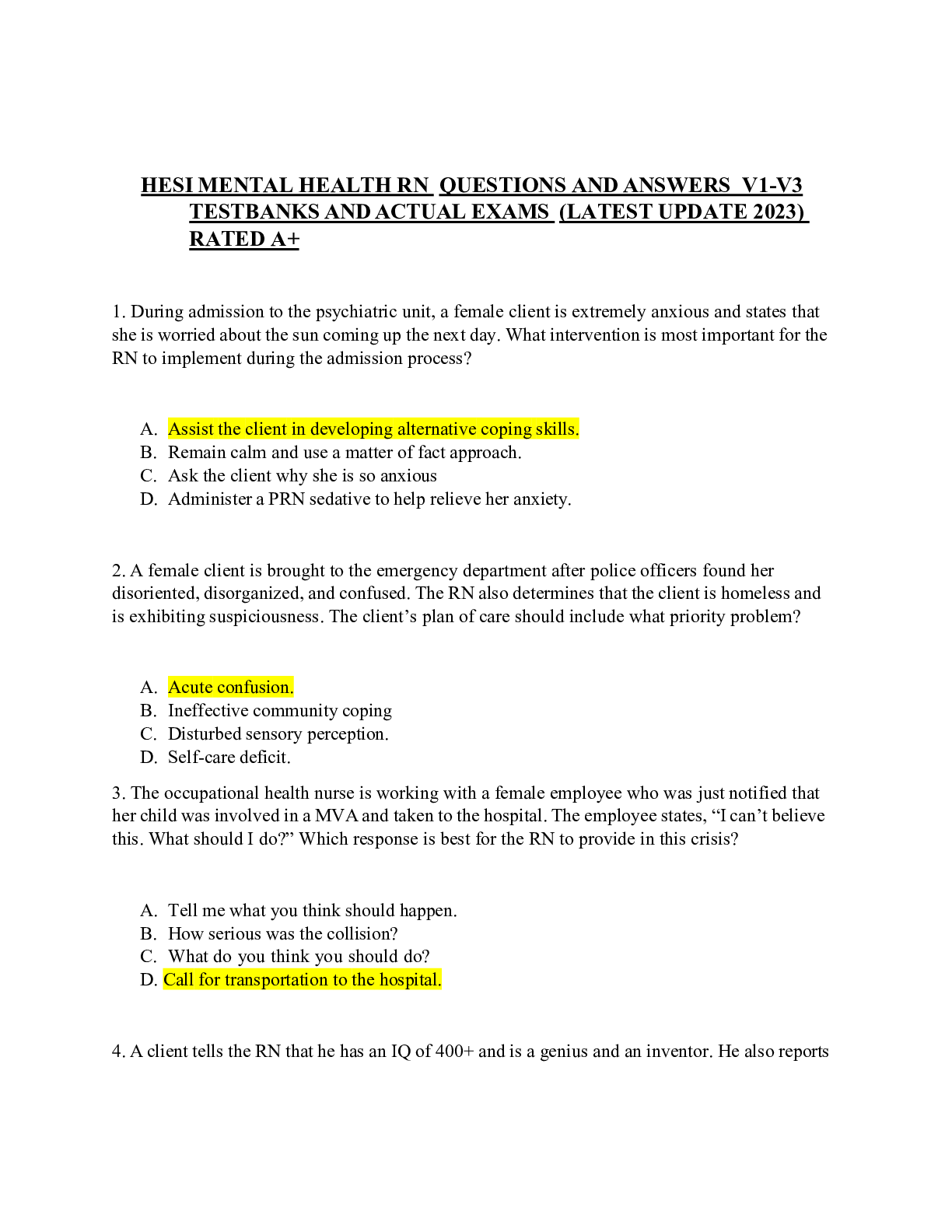

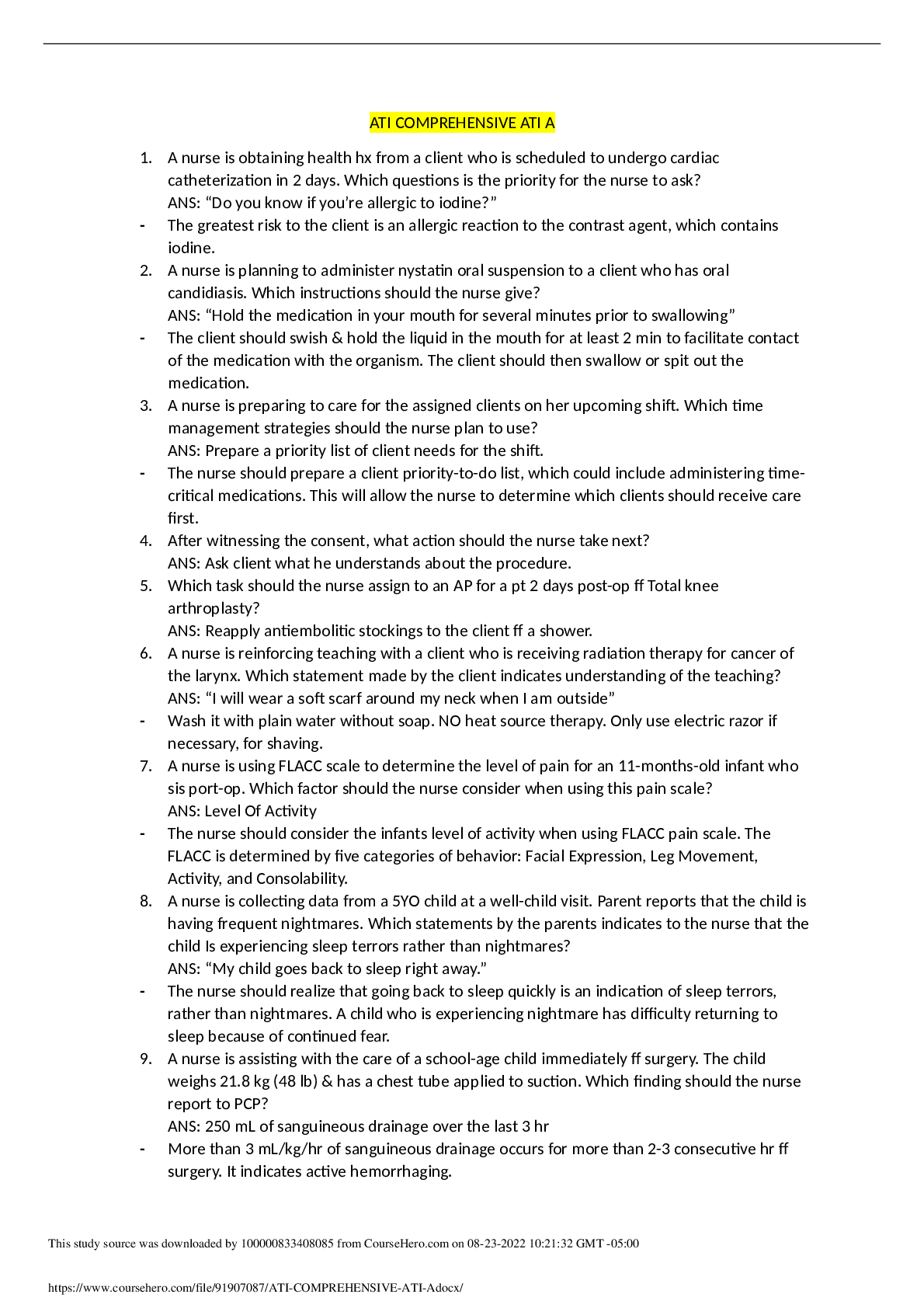

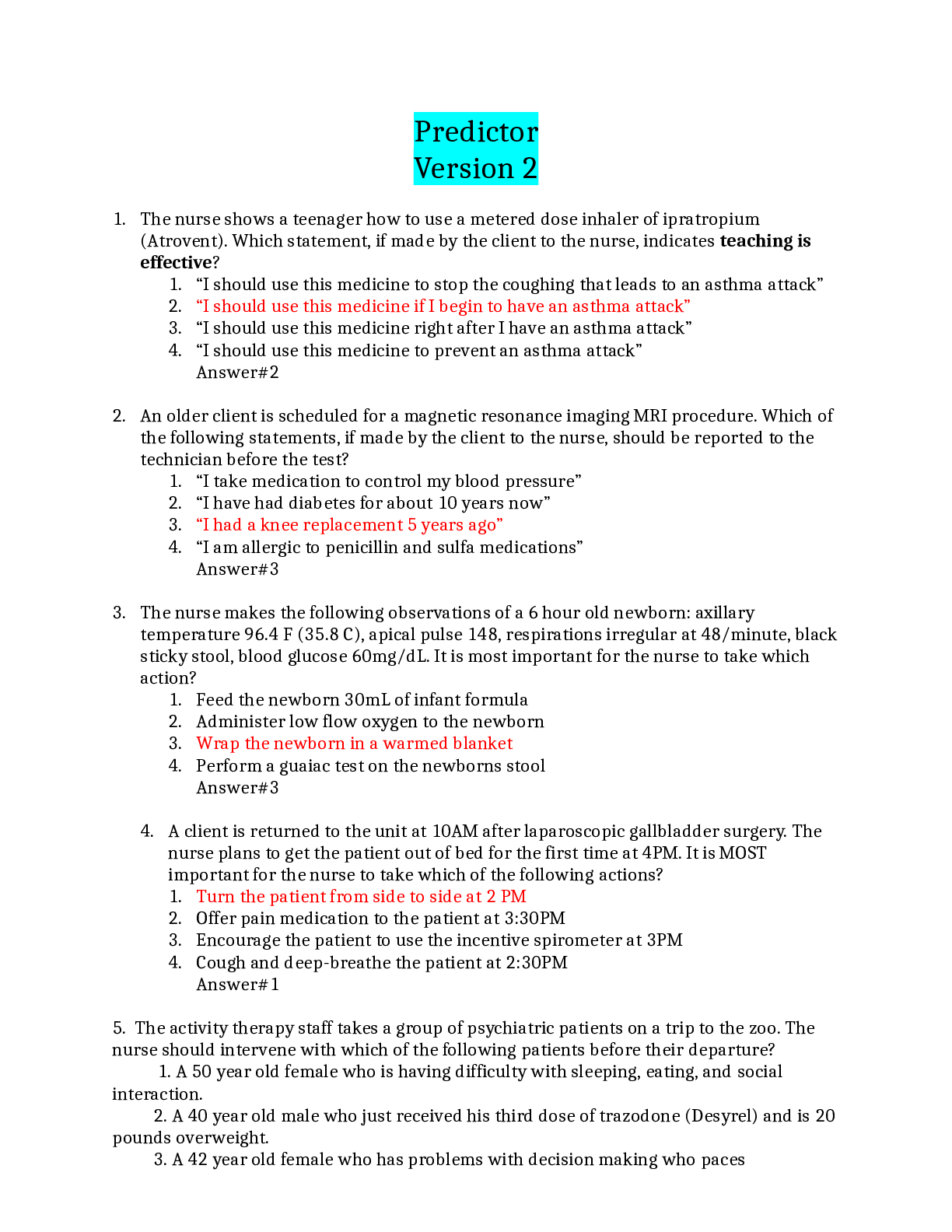
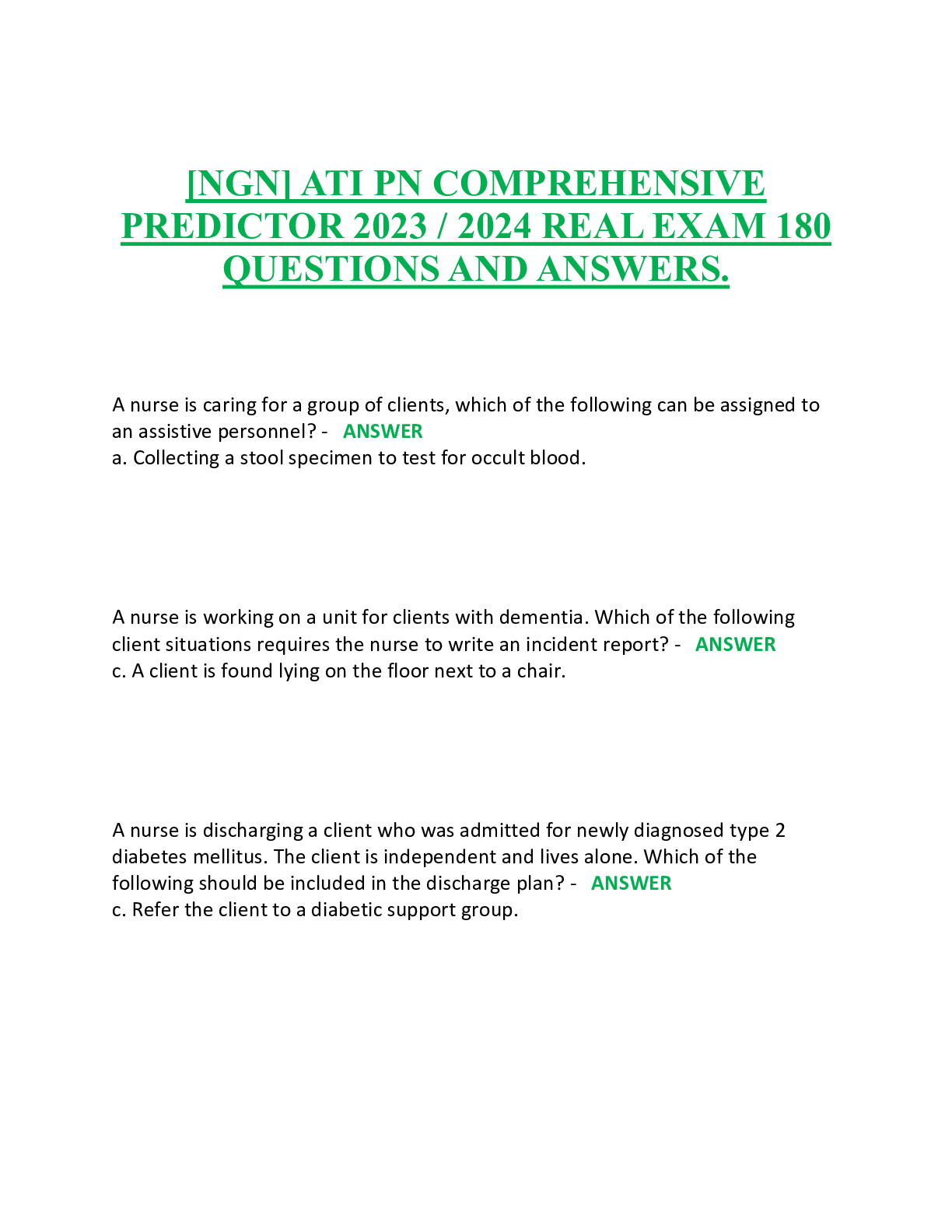
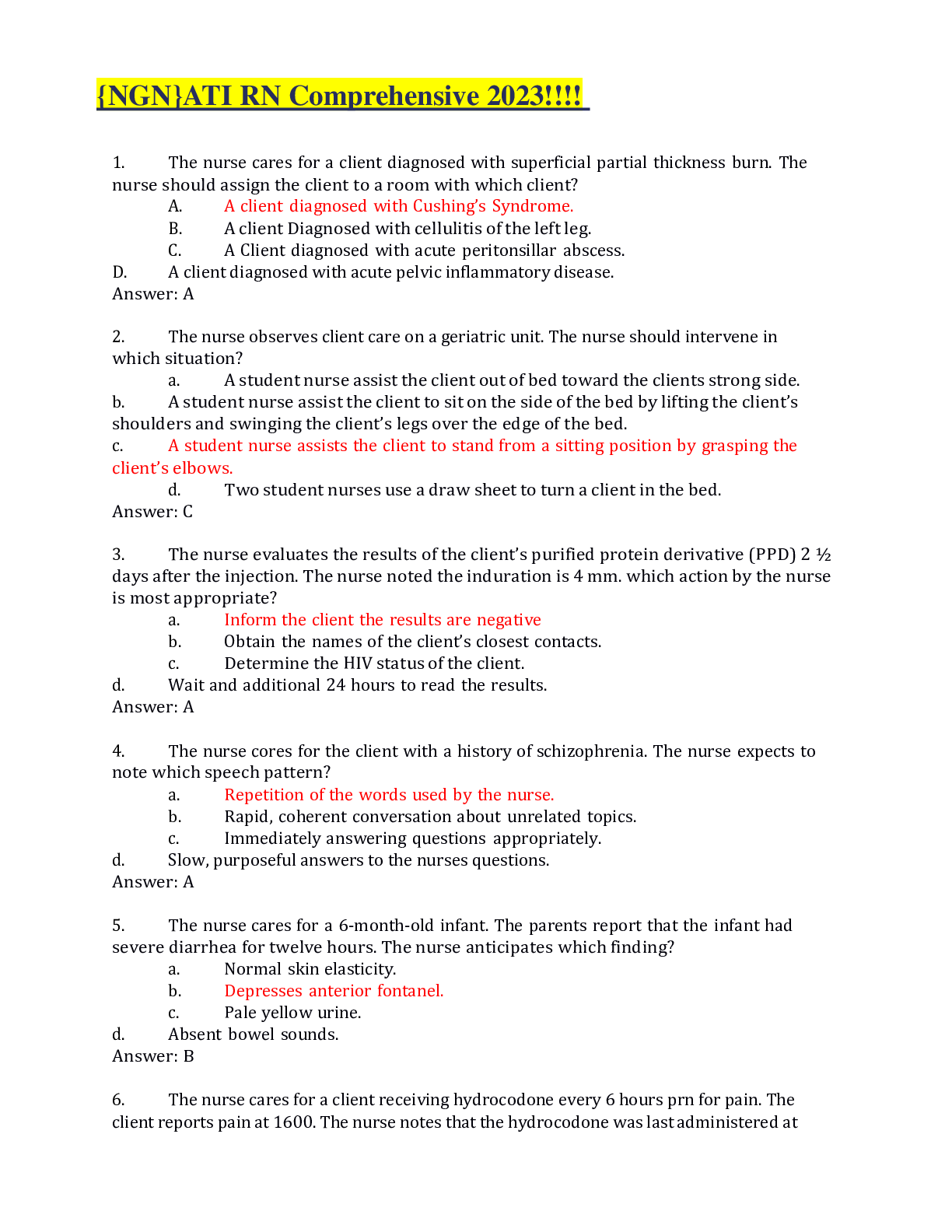
.png)
